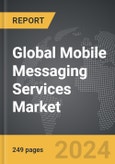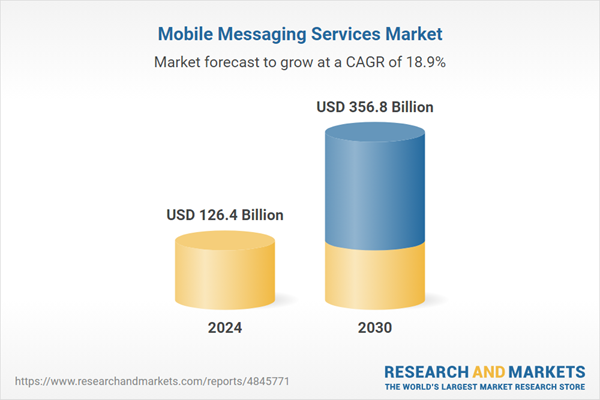The global market for Mobile Messaging Services was valued at US$126.4 Billion in 2024 and is projected to reach US$356.8 Billion by 2030, growing at a CAGR of 18.9% from 2024 to 2030. This comprehensive report provides an in-depth analysis of market trends, drivers, and forecasts, helping you make informed business decisions. The report includes the most recent global tariff developments and how they impact the Mobile Messaging Services market.
Segments: Type (Hardware, Software).
Geographic Regions/Countries: World; United States; Canada; Japan; China; Europe (France; Germany; Italy; United Kingdom; Spain; Russia; and Rest of Europe); Asia-Pacific (Australia; India; South Korea; and Rest of Asia-Pacific); Latin America (Argentina; Brazil; Mexico; and Rest of Latin America); Middle East (Iran; Israel; Saudi Arabia; United Arab Emirates; and Rest of Middle East); and Africa.
The analysts continuously track trade developments worldwide, drawing insights from leading global economists and over 200 industry and policy institutions, including think tanks, trade organizations, and national economic advisory bodies. This intelligence is integrated into forecasting models to provide timely, data-driven analysis of emerging risks and opportunities.
Global Mobile Messaging Services Market - Key Trends and Drivers Summarized
How Do Mobile Messaging Services Work?
Mobile messaging services have revolutionized the way we communicate, offering instant, convenient, and often free alternatives to traditional SMS and voice calls. These services typically operate over the internet, utilizing data networks to send and receive messages, which can include text, images, videos, and voice notes. Popular platforms such as WhatsApp, Facebook Messenger, WeChat, and Telegram have harnessed this technology, allowing users to connect with individuals or groups globally with just a few taps on their smartphones. The core functionality involves sending data packets through internet protocols, ensuring messages are delivered in real-time. End-to-end encryption is a standard feature in many of these services, providing a high level of security and privacy for users. This encryption means that only the communicating users can read the messages, safeguarding against interception by third parties. The ability to integrate these services with other applications and services, such as social media, banking, and customer service platforms, further enhances their utility and adoption.What Are the Key Features and Innovations in Mobile Messaging?
The evolution of mobile messaging services has seen the introduction of numerous innovative features that enhance user experience and engagement. Group chats, voice and video calls, multimedia sharing, and status updates are now standard offerings. Features like disappearing messages, which auto-delete after a set period, and message reactions, allowing users to quickly respond with emojis, have gained popularity. Additionally, chatbots and AI-driven features are becoming more prevalent, providing automated responses and personalized interactions for businesses and customer service applications. Integration with payment systems is another significant innovation, enabling peer-to-peer money transfers within the messaging apps. This functionality is especially popular in platforms like WeChat and WhatsApp, transforming them into comprehensive ecosystems for communication, commerce, and social interaction. Furthermore, the development of rich communication services (RCS) aims to replace traditional SMS, providing enhanced messaging capabilities without the need for third-party apps, thereby creating a more seamless communication experience across different devices and networks.How Are Mobile Messaging Services Impacting Society and Business?
Mobile messaging services are not only transforming personal communication but also having a profound impact on business operations and societal interactions. In the business realm, these platforms offer new channels for marketing, customer service, and internal communication. Companies leverage messaging apps to engage with customers through personalized marketing campaigns, provide instant customer support, and facilitate remote team collaboration. The rise of business APIs and dedicated business accounts on platforms like WhatsApp and Facebook Messenger allows for streamlined communication between businesses and consumers. On a societal level, mobile messaging has enabled greater connectivity, bridging geographical and cultural gaps. It plays a crucial role in activism, disaster response, and community building, as evidenced by its use in coordinating relief efforts during natural disasters and mobilizing social movements. The accessibility and immediacy of these services empower individuals to share information and organize more effectively than ever before.What Drives the Growth in the Mobile Messaging Services Market?
The growth in the mobile messaging services market is driven by several factors, encompassing technological advancements, shifting consumer behaviors, and expanding use cases. The proliferation of smartphones and the increasing availability of high-speed internet have significantly lowered the barriers to entry for users worldwide. This widespread accessibility fuels the adoption of mobile messaging apps. Additionally, the continuous innovation in app features, such as AI integration, multimedia sharing, and enhanced security measures, keeps users engaged and attracts new users. Consumer behavior is also shifting towards favoring digital communication over traditional methods, driven by the convenience, immediacy, and multifaceted capabilities of messaging apps. The rise of remote work and the need for efficient digital communication tools have further spurred the adoption of these services in professional settings. Moreover, the integration of messaging platforms with other digital services, such as e-commerce and financial transactions, expands their functionality and market appeal. Businesses' increasing reliance on these platforms for marketing and customer engagement creates additional demand, solidifying the role of mobile messaging services as essential tools in both personal and professional contexts.Report Scope
The report analyzes the Mobile Messaging Services market, presented in terms of units. The analysis covers the key segments and geographic regions outlined below.Segments: Type (Hardware, Software).
Geographic Regions/Countries: World; United States; Canada; Japan; China; Europe (France; Germany; Italy; United Kingdom; Spain; Russia; and Rest of Europe); Asia-Pacific (Australia; India; South Korea; and Rest of Asia-Pacific); Latin America (Argentina; Brazil; Mexico; and Rest of Latin America); Middle East (Iran; Israel; Saudi Arabia; United Arab Emirates; and Rest of Middle East); and Africa.
Key Insights:
- Market Growth: Understand the significant growth trajectory of the Hardware segment, which is expected to reach US$231.6 Billion by 2030 with a CAGR of a 17.1%. The Software segment is also set to grow at 22.9% CAGR over the analysis period.
- Regional Analysis: Gain insights into the U.S. market, valued at $34.0 Billion in 2024, and China, forecasted to grow at an impressive 24.6% CAGR to reach $83.0 Billion by 2030. Discover growth trends in other key regions, including Japan, Canada, Germany, and the Asia-Pacific.
Why You Should Buy This Report:
- Detailed Market Analysis: Access a thorough analysis of the Global Mobile Messaging Services Market, covering all major geographic regions and market segments.
- Competitive Insights: Get an overview of the competitive landscape, including the market presence of major players across different geographies.
- Future Trends and Drivers: Understand the key trends and drivers shaping the future of the Global Mobile Messaging Services Market.
- Actionable Insights: Benefit from actionable insights that can help you identify new revenue opportunities and make strategic business decisions.
Key Questions Answered:
- How is the Global Mobile Messaging Services Market expected to evolve by 2030?
- What are the main drivers and restraints affecting the market?
- Which market segments will grow the most over the forecast period?
- How will market shares for different regions and segments change by 2030?
- Who are the leading players in the market, and what are their prospects?
Report Features:
- Comprehensive Market Data: Independent analysis of annual sales and market forecasts in US$ Million from 2024 to 2030.
- In-Depth Regional Analysis: Detailed insights into key markets, including the U.S., China, Japan, Canada, Europe, Asia-Pacific, Latin America, Middle East, and Africa.
- Company Profiles: Coverage of players such as BT GROUP PLC, KDDI Corporation, LM Ericsson Telefon AB, Nokia Corporation, Numerex Corporation and more.
- Complimentary Updates: Receive free report updates for one year to keep you informed of the latest market developments.
Some of the 122 companies featured in this Mobile Messaging Services market report include:
- BT GROUP PLC
- KDDI Corporation
- LM Ericsson Telefon AB
- Nokia Corporation
- Numerex Corporation
- Orange SA
- SK Telecom Co., Ltd.
- Telefonaktiebolaget LM Ericsson
- T-Mobile US, Inc.
- Verisign, Inc.
- Verizon Communications, Inc.
- Vodafone Group PLC
Tariff Impact Analysis: Key Insights for 2025
Global tariff negotiations across 180+ countries are reshaping supply chains, costs, and competitiveness. This report reflects the latest developments as of April 2025 and incorporates forward-looking insights into the market outlook.The analysts continuously track trade developments worldwide, drawing insights from leading global economists and over 200 industry and policy institutions, including think tanks, trade organizations, and national economic advisory bodies. This intelligence is integrated into forecasting models to provide timely, data-driven analysis of emerging risks and opportunities.
What’s Included in This Edition:
- Tariff-adjusted market forecasts by region and segment
- Analysis of cost and supply chain implications by sourcing and trade exposure
- Strategic insights into geographic shifts
Buyers receive a free July 2025 update with:
- Finalized tariff impacts and new trade agreement effects
- Updated projections reflecting global sourcing and cost shifts
- Expanded country-specific coverage across the industry
Table of Contents
I. METHODOLOGYII. EXECUTIVE SUMMARY2. FOCUS ON SELECT PLAYERSIII. MARKET ANALYSISIV. COMPETITION
1. MARKET OVERVIEW
3. MARKET TRENDS & DRIVERS
4. GLOBAL MARKET PERSPECTIVE
UNITED STATES
CANADA
JAPAN
CHINA
EUROPE
FRANCE
GERMANY
ITALY
UNITED KINGDOM
SPAIN
RUSSIA
REST OF EUROPE
ASIA-PACIFIC
AUSTRALIA
INDIA
SOUTH KOREA
REST OF ASIA-PACIFIC
LATIN AMERICA
ARGENTINA
BRAZIL
MEXICO
REST OF LATIN AMERICA
MIDDLE EAST
IRAN
ISRAEL
SAUDI ARABIA
UNITED ARAB EMIRATES
REST OF MIDDLE EAST
AFRICA
Companies Mentioned (Partial List)
A selection of companies mentioned in this report includes, but is not limited to:
- BT GROUP PLC
- KDDI Corporation
- LM Ericsson Telefon AB
- Nokia Corporation
- Numerex Corporation
- Orange SA
- SK Telecom Co., Ltd.
- Telefonaktiebolaget LM Ericsson
- T-Mobile US, Inc.
- Verisign, Inc.
- Verizon Communications, Inc.
- Vodafone Group PLC
Table Information
| Report Attribute | Details |
|---|---|
| No. of Pages | 249 |
| Published | April 2025 |
| Forecast Period | 2024 - 2030 |
| Estimated Market Value ( USD | $ 126.4 Billion |
| Forecasted Market Value ( USD | $ 356.8 Billion |
| Compound Annual Growth Rate | 18.9% |
| Regions Covered | Global |









